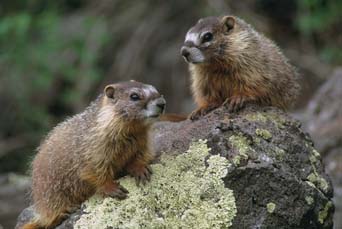
one of Utah’s true hibernators
Photo courtesy Utah Division of Wildlife Resources,
Copyright Lynn Chamberlain
As Utah’s blanket of snow grows thicker and cold temperatures set in, some of our furred friends quietly retire for the winter. Gone are the marmots that basked on sunny slopes, the bears that browsed in the forests, and the bats that winged silently overhead.
Animals have a number of different strategies to help them survive in winter. Some, such as hummingbirds, migrate to a more temperate climate. Some have special adaptations that allow them to withstand cold temperatures such as mink, which grow wonderfully thick winter coats. And some, such as marmots, bears, and bats, simply find a cozy place to sleep away the winter.
The general term for this period of inactivity is “dormancy,” which includes more specific terms such as “hibernation” and “torpor.” During this time, an animal’s heart rate, breathing rate and metabolism slows down considerably. Contrary to popular belief, most of the mammals that hole up for the winter do not actually hibernate. The term hibernation applies to only a small portion of our Utah mammals – a few species of bats and some rodents like the marmot. True hibernation means that an animal’s metabolism turns off to the point that its body temperature nearly matches that of the environment around it. And in winter, this means that body temperatures can drop to nearly freezing. Hibernating animals become unresponsive to environmental stimuli such as loud noises and being touched, and it takes hours and lots of energy for them to finally awaken.

which survives winter
in a state called torpor
Photo courtesy Utah Division of Wildlife Resources,
Copyright Lynn Chamberlain
In contrast, consider the bear, which does not technically hibernate, but instead enters a state called torpor or ‘winter lethargy’. A bear’s body temperature does decrease during this time but never approaches freezing. Bears also remain semi-active occasionally moving about in their dens, or even giving birth and tending to their newborns. Other animals that become largely inactive in winter but do not fully hibernate include skunks, raccoons, and opossums. These animals can respond very well to environmental stimuli and can resume their full abilities in less than a minute if disturbed – something to keep in mind in case you stumble across a bear’s den this winter.
Thanks to the Rocky Mountain Power Foundation for supporting research and development of this Wild About Utah topic. For the Stokes Nature Center and Wild About Utah, this is Andrea Liberatore.
Credits:
Photos: Courtesy Utah Division of Wildlife Resources and Copyright Lynn Chamberlain, photographer
Text: Andrea Liberatore, Stokes Nature Center
Additional Reading:
Encyclopædia Britannica. 2010. “Dormancy.” Encyclopædia Britannica Online. https://www.britannica.com/EBchecked/topic/169514/dormancy (Accessed Nov. 20, 2010)
New Jersey Division of Fish and Wildlife. 2010. Black Bear Biology and Behavior. https://www.state.nj.us/dep/fgw/bearfacts_biology.htm (Accessed Nov. 20, 2010)
